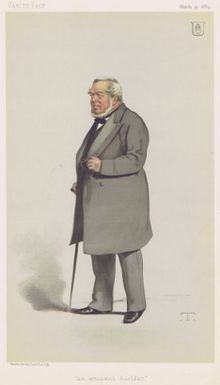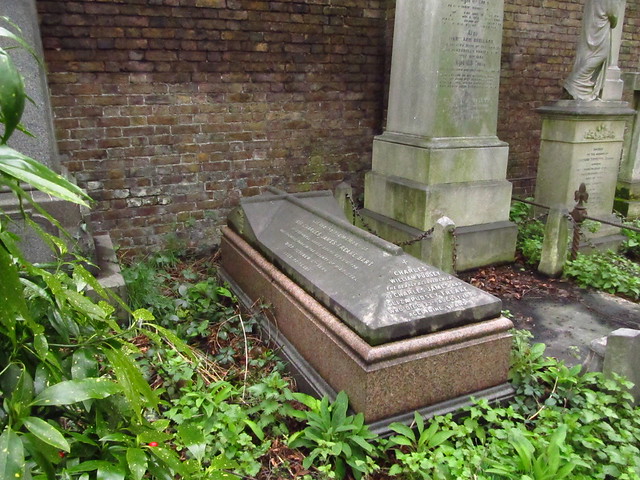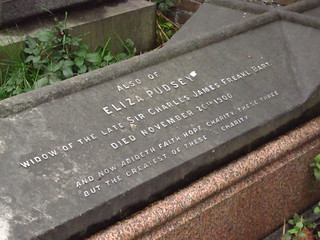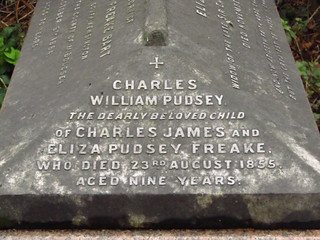|
|
Charles James Freake (7 April 1814 - 6 October 1884) architect, builder, and philanthropist. He was the son of Charles Freake (d approx 14 September 1837), victualler of The Royal Oak Public House, Elizabeth Street Square, (where was that..?) Middlesex and Margaret Anne Cutler, dates unknown. This article is the most informative, tells his life story and I will reproduce very little from it here.
His erection at his own cost of the National Training School for Music (now the Royal College of Organists) in 1874-5 was the principal factor in securing him a baronetcy in 1882. It has also been suggested that he was also recognised in this way for the help he gave the then Prince of wales, later Edward VII in securing his relationship with Victorian actress Lily Langtrey. By the time of his death on 6 October 1884 he was a very wealthy man. Besides his property in Kensington, he owned an estate and Fulwell Park, a house at Twickenham, another at Kingston-upon-Thames, and left a personal estate worth upwards of £718,000 to his grandson Thomas Charles.
|
|
Extract from here.
The Great Exhibition of 1851 set in motion a move towards an English musical renaissance with its display of national pride. Prince Albert and Henry Cole of the Royal Society of Arts were behind the plan of the exhibition, which was held in Hyde Park, South Kensington. Henry Cole played an integral role in both the design and execution of the original Exhibition, as well as the development of the South Kensington plans.
After Prince Albert’s death in 1861, Cole decided to move forward with the creation of a music academy. Cole was also a lobbyist for the Education Act of 1870, which for the first time made specific provisions for music education in elementary schools.30 Cole had originally wanted to use the Royal Academy of Music (which was founded in 1822) as the core for expanding a larger musical institution, however, he met with much resistance from its principal, William Sterndale Bennett, who wanted the school to remain independent.
Cole instead proceeded with a “National Training School of Music” in 1873. The location for the school was next to the Royal Albert Hall, the land being donated by the Exhibition Commissioners. A London builder, Charles Freake, paid for the building himself, and it was designed by Cole’s son, Lieutenant H.H. Cole of the Royal Engineers. Arthur Sullivan was the school’s first principal when it first opened in 1876. The National Training School would be transformed into the Royal College of Music and then Royal College of Organists.
|
|
Charles built St Peter’s, Cranley Gardens, Kensington, built for the Church of England but an Armenian church since 1975. His wife’s funeral service was held here, and Arthur Seymour Sullivan (13 May 1842 - 22 November 1900) (of Gilbert & Sullivan fame) was the first organist and choirmaster of St. Peter's Church, Cranley Gardens, Kensington (consecrated 29 June 1867).
|
|
Whitehall, May 10, 1882.
THE Queen has been pleased to direct Letters Patent to be passed under the Great Seal, granting the dignity of a Baronet of the United Kingdom of Great Britain and Ireland unto the undermentioned Gentlemen, namely:—
Charles James Freake, of Cromwell House, in the parish of St. Mary Abbots, Kensington and Fulwell Park, in the parish of Twickenham both in the county of Middlesex, Esq., and the heirs male of his body lawfully begotten.
|
|
- Residence of Sir Charles James Freake 21 Cromwell Road
This fine corner house, which is now the French Consulate, was the home of a builder and patron of the arts called "the cleverest of all the speculating builders" of his time. Freake was not clever enough, however, to make Lillie Langtry receptive to the Prince of Wales's first seduction attempt at an amorous assignation in his house. Freake lived in the imposing residence he had built in 1860 with his wife and daughter, three female relations, a butler, two footmen and seven other servants. By arranging nefarious financial favours, he had managed to obtain the patronage of the Prince of Wales, who sometimes attended musical and theatrical performances staged in the great ballroom of the house. After the prince had been introduced to Lillie, she was astonished a short time later to be taken aside by the heavy-handed Mr. Freake and informed that the prince was interested in paying his respects to her in the privacy of the Freake mansion. The date was set and the appointment kept, but unlike other ladies summoned by the prince, Lillie cunningly postponed the actual seduction, allowing time for the prince to become acquainted with her more enduring charms. This ingenious strategy may have been responsible for her ascension to the position of his first officially recognized royal mistress. The son of a coal merchant and publican, Freake was granted a baronetcy in 1882, some years after he had built, at his own cost, the National Training School for Music (now the Royal College of Organists) in 1875 and made his mansion available for other princely assignations. The prince was particularly interested in the school and, according to Gladstone's political secretary, had "persistently and somewhat questionably [if not fishily] pressed Freake's name on the prime minister"; hence the reward of the title. |
|
Fulwell Park, Middlesex, and of Bank-grove, Kingston-on-Thames, Surrey. (Bank Grove was a house, demolished in 1980, on the Thames just north of the Boaters public house.)
Announcement of his death. Obituary.
(Sir Charles famously only allowed straight chimneys in his buildings after his solicitor told him about soot wart (Wikipedia article, NOT for the squeamish) — a form of cancer of the scrotum prevalent in child sweeps. Straight chimneys allowed brushes to be used for the entire chimney length and would have saved many Victorian working class children from a painful and premature death.) Wait until that comes up in a TV quiz!
|

|
|
The Copt Hall Estate
The Copt Hall estate in Twickenham stretched, during the first part of the 19th Century, from Holly Road, behind Heath Road, north to the river Crane. It came into the possession of Sir Charles in about 1842 and the surviving house was demolished shortly after. The name is perpetuated in the road named Copthall Gardens. (Twickenham Museum)
Details of some of his local philanthropy are here, scroll down to Freake. He was created1st Baronet Freake, of Cromwell House, Kensington and Fulwell Park on 23 May 1882 in recognition of his philanthropic work.
|
|

|
|
While doing earlier research into the Freakes I must have read that Sir Charles was buried in West Brompton Cemetery, West London, but it was purely by chance that his name caught my eye when we were walking through, looking for other notables. He is buried with his wife Eliza Pudsey and son Charles William Pudsey. (I do not know why the nine-year-old was buried under his mother’s name.) A few hundred yards from the cemetery’s north entrance we found the Lily Langtry Public House
|
|

|

|
|
